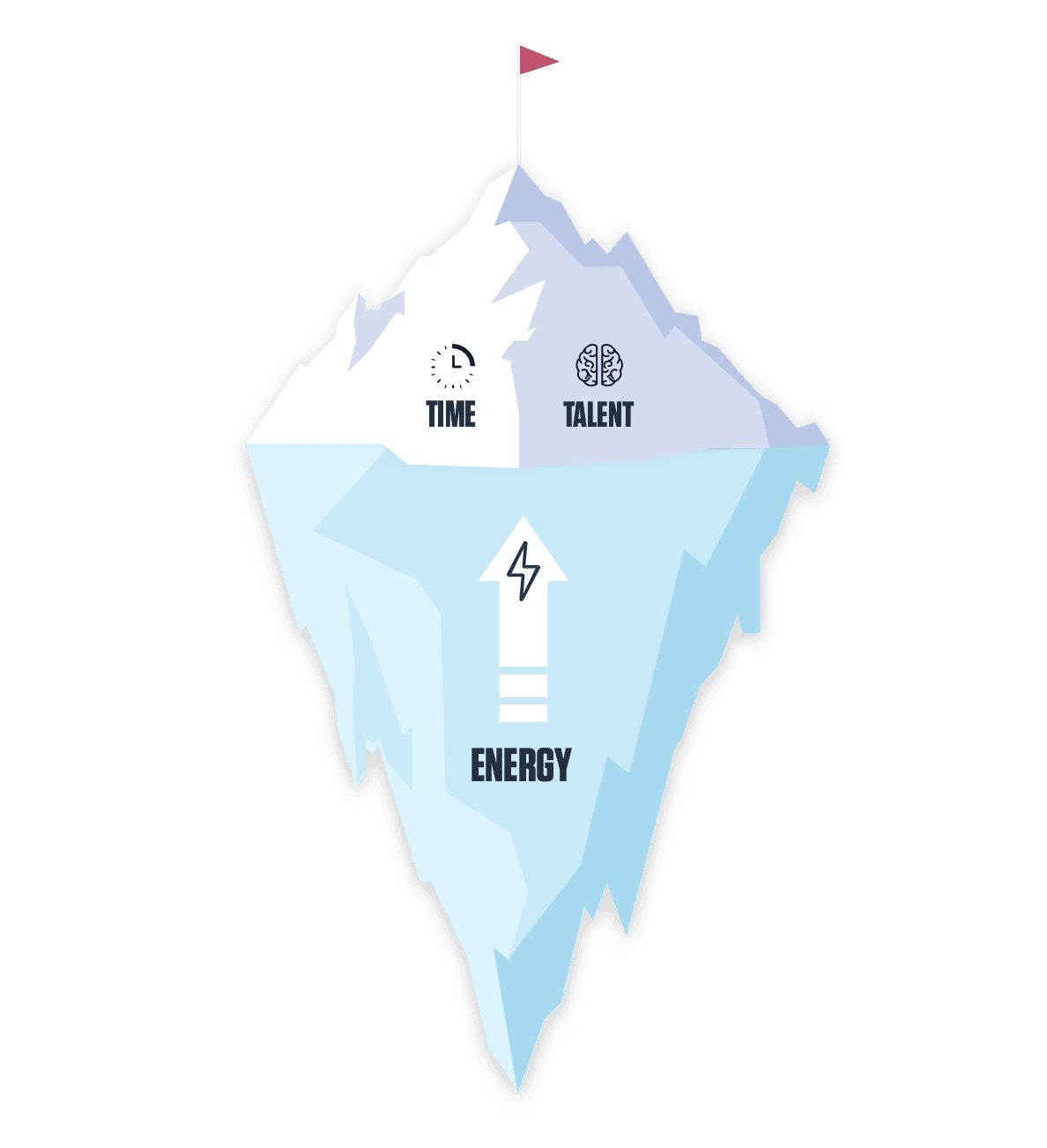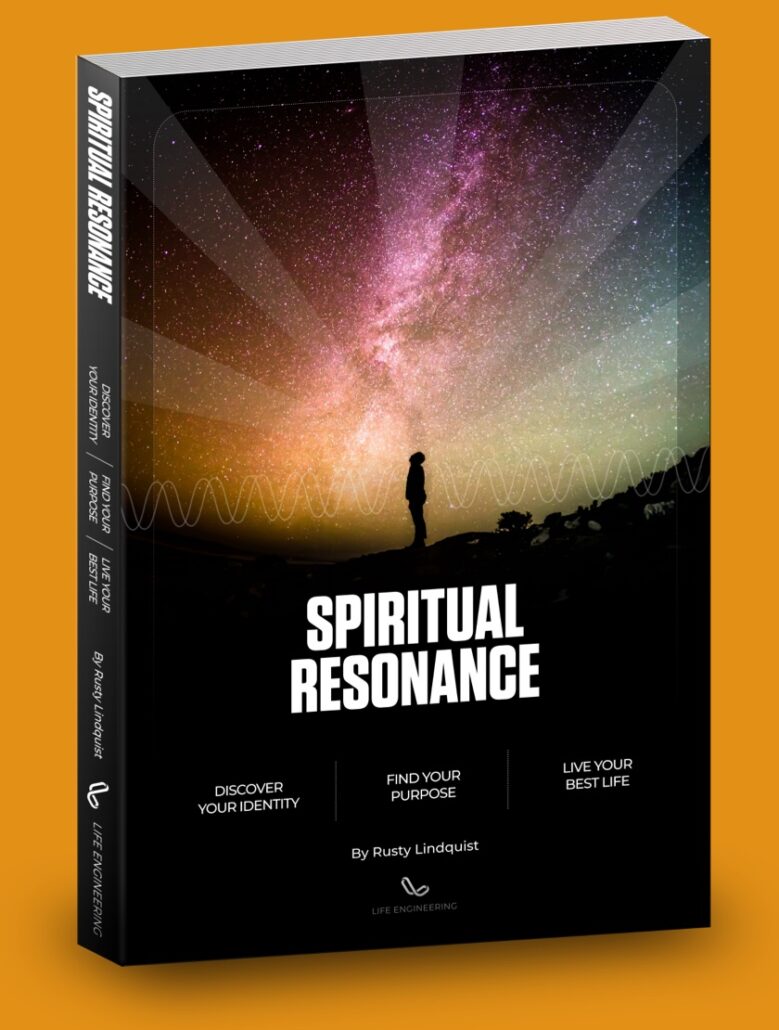
an overview
Your organization’s Emotional Capital is the total Energy available inside your organization. That energy can be activated and unleashed to drive people performance, which in turn drives organizational performance.
Total energy is driven by Employee Satisfaction and Employee Engagement. Learning how to measure and manage that energy (and its sources) is critical to achieving outstanding organizational outcomes.
How energy drives
ORGANIZATIONAL PERFORMANCE
Organizational performance is built on the foundation of people performance, because businesses don’t create value, people do.
And when it comes to people performance, there are really only three variables… there’s time, talent and energy.
We understand time and talent. We work hard to measure and manage it. It’s above the waterline of our organizational attention. But when it comes to performance, it’s what lies below the waterline that matters most—and that’s energy.
Energy is the mass beneath the surface. Energy is what drives up the impact of our time and talent.
When our energy for our work is high, our time and talent lead to performance. But when our energy for our work is low, the impact of our time and talent shrinks.
The research shows that when it comes to performance, between time, talent, and energy… energy matters most.
So if we want to drive organizational performance, we have to get good at optimizing for energy.
The first aspect of optimizing for energy is understanding the two main components that comprise it… and that’s employee satisfaction and employee engagement.
outcomes
performance and achievement
we help organizations
measure and manage energy
to increase performance

energy
satisfaction and engagement
SATISFACTION
EMPLOYEE
To truly drive performance, we have to go DEEP.
More than just solving for time and talent,
we have to solve for energy.
ENGAGEMENT
EMPLOYEE

TO INCREASE
ORGANIZATIONAL PERFORMANCE
YOU HAVE TO INCREASE PEOPLE PERFORMANCE
Organizational performance is built on the foundation of people performance, because businesses don’t create value, people do.
And when it comes to people performance, there are really only three variables… there’s time, talent and energy.
We understand time and talent. We work hard to measure and manage it. It’s above the waterline of our organizational attention. But when it comes to performance, it’s what lies below the waterline that matters most—and that’s energy.
Energy is the mass beneath the surface. Energy is what drives up the impact of our time and talent.
When our energy for our work is high, our time and talent lead to performance. But when our energy for our work is low, the impact of our time and talent shrinks.
The research shows that when it comes to performance, between time, talent, and energy… energy matters most.
So if we want to drive organizational performance, we have to get good at optimizing for energy.
The first aspect of optimizing for energy is understanding the two main components that comprise it… and that’s employee satisfaction and employee engagement.
performance and productivity
We like to use the analogy of an iceberg, and in that analogy, what’s above the waterline (or what we pay attention to) are our behaviors.
They’re above the waterline because they’re easy to observe. Behaviors are what we do with our time and talent.
Our behaviors lead to the peak, which is ultimately our performance outcomes. To increase our peak performance outcomes, we have some options.
First, we can add mass to the slope of “time” by simply increasing the amount of time we spend doing something. More time (generally) equals more work, and more work (generally) results in more outcomes.
The problem, of course, is that time is very limited, and when it comes our our employees, we’re usually already doing all we can to maximize the “slope” of time.
The other option, of course, is that we add mass to the slope of talent, increasing how “well” we do something and pursuing mastery.
Talent development is a fantastic way to up our peak performance. We should constantly be investing in talent development and talent management (aligning the right talent to do the right work at the right time and under the right circumstances).
Better utilization of Time and Talent is what we all call “productivity.”
Productivity is a key component of performance, and because of this, there are lots of productivity solutions and a lot of effort goes into solving for productivity. It’s really an optimization of behaviors (what we do with our time and talent). But that’s part of the problem.
Because of how easy it is to understand and observe… to measure, and manage behaviors and productivity, we tend to fixate almost exclusively on those two things.
But what lies below the waterline is equally, if not more important.
Because the other way to drive up our peak performance is to add mass to what’s below the surface, and that’s energy.
We call it “below the surface,” because it’s a lot harder to see down there. And because it’s harder to observe and understand, we tend to ignore it, focusing primarily on time and talent to drive performance.
But the activation and application of energy (adding mass to the bottom of the iceberg) is what drives up the impact of our time and talent and leads to performance.
The reality is, you can have all the time and talent you want, but if you don’t have energy for the work, it just won’t lead to performance.
So if we want to maximize employee performance, we need to get good at understanding and optimizing for energy.
energy and employee sentiment
Energy, or the emotion we have for the work we do, for the teams we’re on, for the customers we serve, and for the company we work for, is derived from the ocean of employee sentiment.
Employee sentiment is the emotional undercurrent that flows throughout our organizations.
It’s definitional to our culture. You can feel it within your teams. You can feel it within your organization. The energy that flows through your teams and your company is inextricably part of “who you are.”
And because Energy has such a profound impact on people performance and organizational performance, it’s incumbent upon us, as organizational leaders and executives, to learn how to both measure and manage it.
But knowing how to measure sentiment has been very difficult, let alone knowing how to manage it. It’s an emotion, and because of that, it’s always seemed sort of nebulous and ephemeral. It lacks edges and so we don’t know really what it looks like or where we can push on it.
Sure there are inputs to sentiment that we understand… things like benefits, company meetings, communication, compensation, leadership, etc. We can list lots of inputs to sentiment (which we mostly think of as employee satisfaction), but to truly measure and manage sentiment requires some deep science.
To truly understand sentiment (in order to optimize for energy), we have to understand the difference between its two main components… employee satisfaction and employee engagement.
continue this learning path
learn more about energy

Learn about
employee satisfaction
Employee Satisfaction is the easiest and most effective means of keeping a regular tab on employee sentiment. It forms a core foundation for your strategy on optimizing for Energy.

Learn about
employee engagement
Employee Engagement is the deepest and most thorough means of truly understanding what your employees feel, not just about where they work, but the work they do.
go deeper on this topic
courses from the academy
The Energy Iceberg (Part 1)
Understanding the role of energy in personal progress
When it comes to achievement, there are only three variables... time, talent and energy. We focus on time and talent... but energy matters most. Learn about the interplay of these three, and how optimizing for energy will be the main driver of your success.
Foundations
The Energy Iceberg (Part 2)
How optimizing energy will give you the most thrust
As you move forward on your Journey to Purpose, you must continually draw on the three main levers of personal progress… time, talent, and energy. In this course we'll talk about the limits of time and talent and how to leverage energy to maximize momentum.
Foundations


Responses